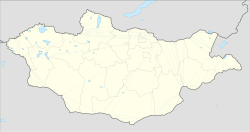| Gandantegchinlen Monastery | |
|---|---|
 Megzed Janraiseg Temple and stupas | |
| Religion | |
| Affiliation | Tibetan Buddhism |
| Sect | Gelug |
| Location | |
| Location | Ulaanbaatar |
| Country | Mongolia |
| Geographic coordinates | 47°55′23″N 106°53′42″E / 47.92306°N 106.89500°E |
| Architecture | |
| Style | Mongolian, Tibetan, and Chinese influences |
| Date established | 1809 |
Gandantegchinlen Monastery (Mongolian: Гандантэгчэнлин хийд, Gandantegchenlin khiid), also known as Gandan Monastery, is a Buddhist monastery in Ulaanbaatar, Mongolia. It was founded in 1809, closed amid persecutions in 1939, and from 1944 to 1989 was the country's only active monastery. Today, it is the center of Buddhism in Mongolia. The monastery has more than 100 resident monks and numerous Buddhist treasures, including a 26-metre (85 ft) statue of Avalokiteśvara made of gilded bronze and precious stones.
YouTube Encyclopedic
-
1/2Views:1 152776
-
Ganden Monastery, Mongolia
-
Mongolia, Gandan Monastery, cont. (2000)
Transcription
Name
The name of the monastery, Gandantegchinlen (Tibetan for "complete rejoicing"), is derived from Ganden Monastery in Tibet, established by Je Tsongkhapa, the founder of the Gelug sect of Tibetan Buddhism. Its translated name in Mongolian is Tegüsbayaskhulangtu, and in Sanskrit it is Tushitamahayanavipa.[1][2]
History

The second Jebtsundamba Khutuktu established a tsanid (Buddhist education center) for the monks of Khüree (modern Ulaanbaatar) in the early 18th century. Datsan (colleges) were built at Dashchoinpel (in 1736), Gungaachoilin (in 1809), and Idgaachoinzinlin (in 1912).
At Gungaachoilin, on a hill west of Khüree, Shar Temple was built in 1809, followed by the Lamrin dugan (assembly hall) in 1824. After he ordered the Khüree clergy to move west, further from encroaching Chinese buildings, the fifth Jebtsundamba Khutuktu built a palace, named Gandantegchinlen, just south of Shar Temple between 1834 and 1838; the monastery itself also took this name. Other buildings were added, including the Tsogchin dugan in 1839 and Ochirdari (Vajradhara) Temple in 1840, which has a silver and gold statue created in 1683 by Zanabazar. Jüd (Tantra) Temple, founded in 1739 by the second Jebtsundamba Khutuktu, is now housed in a yurt. The fifth, seventh, and eighth Jebtsundamba Khutuktus were interred at Gandan, though in 1855 they and their monks moved back to their original palace near the current city center. To celebrate independence from Qing China in 1911, the eighth Jebtsundamba Khutuktu ordered the construction of Megzed Janraiseg (Eye-Opening Avalokiteśvara) Temple, completed in 1913 as Mongolia's tallest monastery building. It had a 25.6-metre (84 ft) statue of the boddhisatva Avalokiteśvara made of gilded bronze and precious stones.[1][2]
Gandan was closed in 1939 during the anti-religious persecutions in Mongolia, and its dugan buildings were razed. Escaping the mass destruction of other monasteries, its surviving buildings were used to house the administration of Töv Province. In 1940, the monastery was placed under direct Soviet military command and used as a stable, ammunition store, and firing range. The statue of Avalokiteśvara was broken apart in 1937 (alternatively by Soviet soldiers in 1938 or 1943), and is thought to have been shipped to Moscow and melted down. In January 1944, the monastery was reopened by dictator Khorloogiin Choibalsan (on the recommendation of Joseph Stalin) as the country's only working monastery. By 1947, it had 57 monks and was holding public services. That year, Mongolian scholars, aided by a few Soviet advisers, intervened to save the Megzed Janraiseg Temple from demolition, and in 1961 the temple was made a national cultural monument. With the advent of religious freedom in 1990, Gandan expanded to 200 monks and began a full-scale renovation. In 1996, a new 26.5-metre (87 ft) statue of Avalokiteśvara, modeled on the old, was dedicated. Built over six years using a mix of government and private funds, it weighs 90 tons and is made of 20 tons of copper, 25 kilograms (55 lb) of silver, 8.6 kilograms (19 lb) of gold, and over 2,100 precious stones.[1][2]
As of 2004, Gandan is Mongolia's largest active monastery, with 100 monks. It has 70,000 Buddhist manuscripts and woodblock prints, including the 108-volume Ganjuur (precepts), 226-volume Danjuur (commentaries), and other works in Mongolian, Tibetan, and Sanskrit, some written in the "nine precious materials": gold, silver, turquoise, lapis lazuli, coral, pearl, mother-of-pearl, copper, and steel. The monastery's other treasures include a 15-kilogram (33 lb) silver statue of Tsongkhapa. Despite development in Ulaanbaatar, its vicinity has remained occupied by the monks' yurts. Gandan is considered the center of Mongolian Buddhism, and its khamba lama (abbot) is held to be its leader.[1][2] Since 1992, the abbot of Gandan has been Gabju Demberel Choijamts.[3]
Gallery
-
Southern gateway
-
Stupa
-
-
Statue of Avalokiteśvara
-
Decorated door of Dzuu Temple
-
Inscription at entrance to Ochirdari Temple
-
Monastery buildings
-
Stone tablet with Soyombo symbol
-
-
References
- ^ a b c d Sanders, Alan J. K. (2010). Historical Dictionary of Mongolia. Scarecrow Press. ISBN 9780810861916.
- ^ a b c d Atwood, Christopher P. (2004). Encyclopedia of Mongolia and the Mongol Empire. Facts On File. ISBN 9780816046713.
- ^ "Khamba Lama Gabju, Supreme Head of Mongolian Buddhists, on the Buddhist Revival in Mongolia". Buddhistdoor Global. Retrieved 2023-07-03.
External links
 Media related to Gandan Monastery at Wikimedia Commons
Media related to Gandan Monastery at Wikimedia Commons- Official website of the Gandan Monastery











